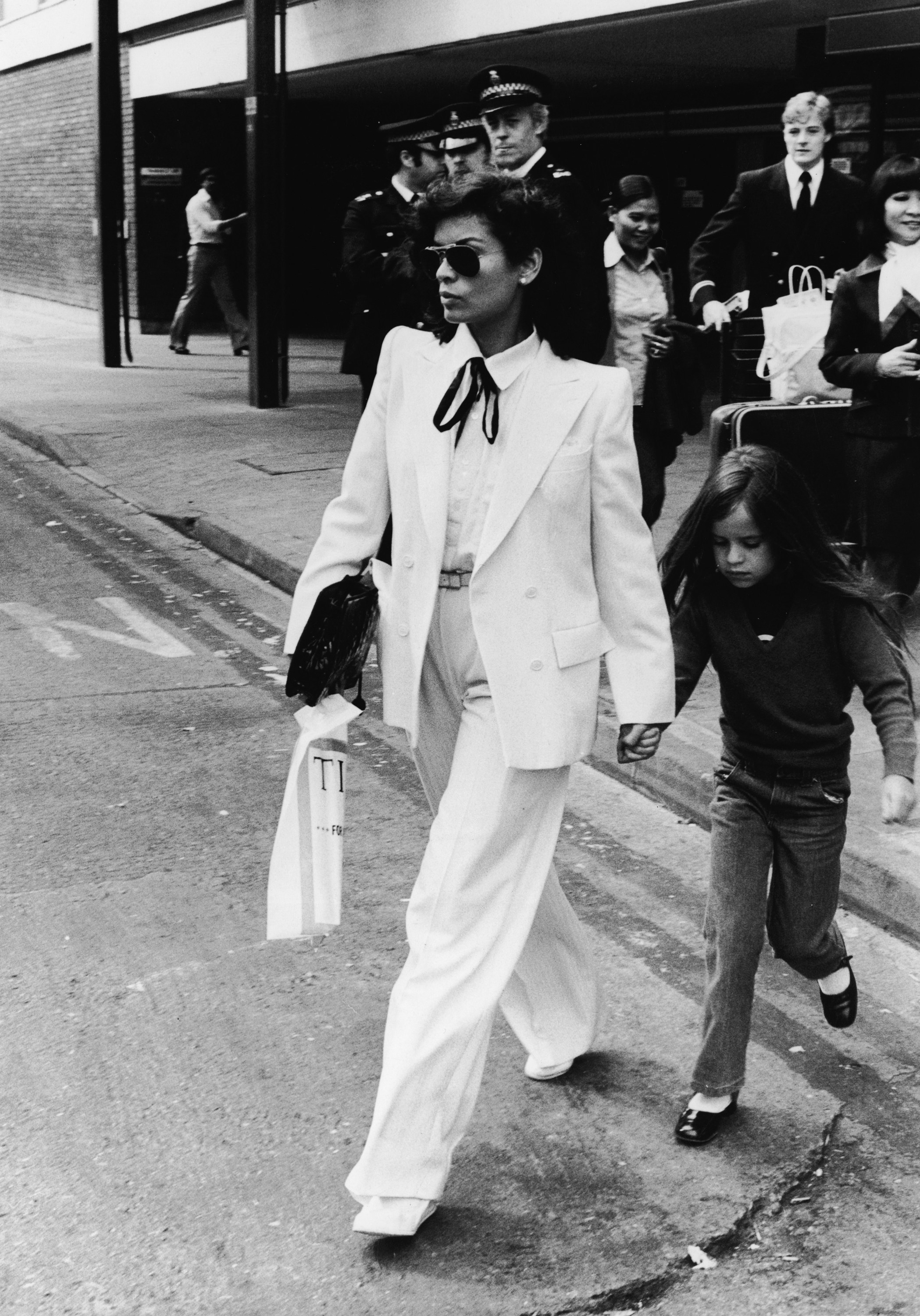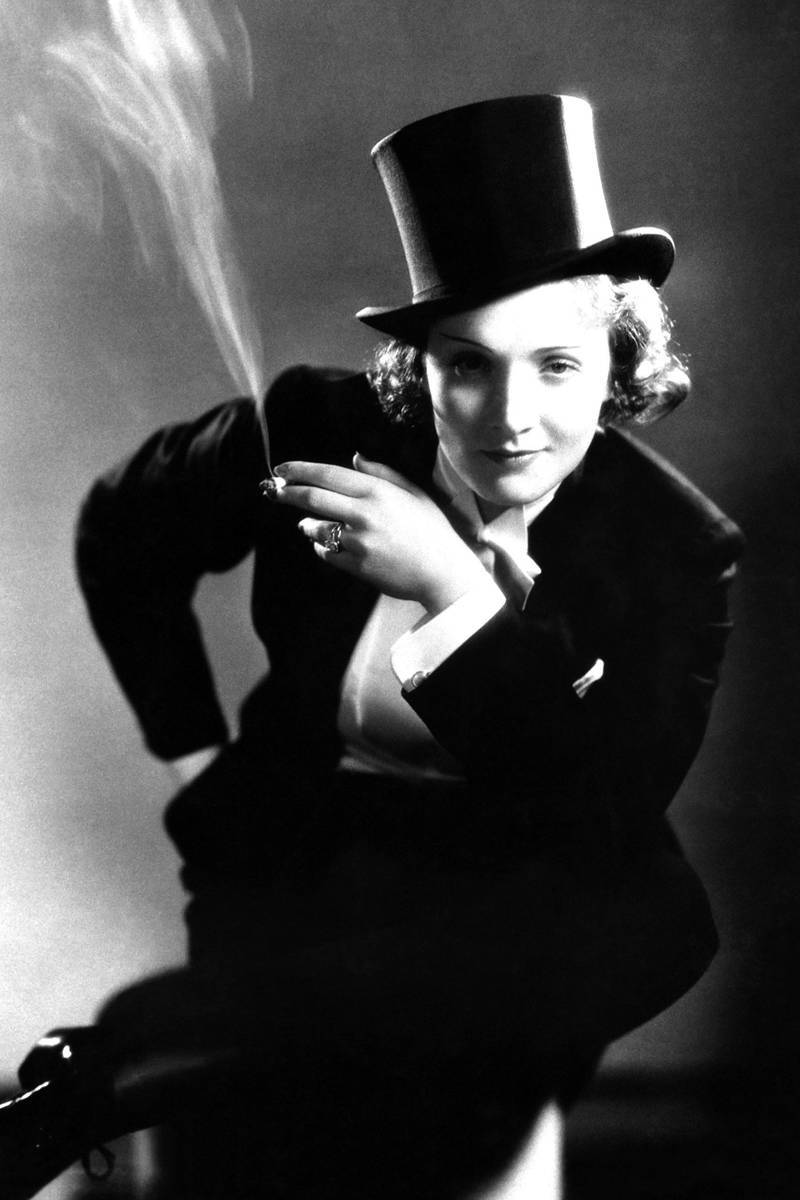The Importance of the 1980s Power Suit
Header and Thumbnail Image from: https://www.vogue.com/article/how-to-wear-80s-power-suit
By Hannah Schmidt-Rees
Marlene Dietrich in the film Morocco, 1930.
Most known in the 1980s, the power suit is an (typically) exaggerated man’s business suit that is worn by a woman, in order to associate masculine traits (such as authority and respect) to the woman wearing it.
The first well-known instance of the power suit was worn by German-American actress Marlene Dietrich in the 1930 film Morocco. Marlene enters a nightclub dressed in a man’s tuxedo and proceeds to walk around the venue while embodying masculine characteristics and masquerading her sexuality, even kissing a woman in one scene. Both of these acts challenged society at the time; and with Marlene wearing suits on and off screen; began the trend of a woman wearing a suit in the public eye to gain authority and break women’s gender and sexuality stereotypes.
For the next 50 years, the power suit primarily resurfaced twice; coinciding with an increase in feminist ideologies and women’s need for equality. The Chanel Suit, designed in 1923 by Coco Chanel rewrote the expectations for women’s dress after the first World War. Originally created out of tweed (a material commonly used for men’s sportswear at the time), the collarless button-up jacket and matching skirt created an outfit that was both feminine, masculine and ultimately, comfortable enough for a woman to complete important work. Yves Saint Laurent’s ‘Le Smoking’ Suit, made in 1966, was a man’s tuxedo suit redesigned to better fit a woman’s body. This three-piece suit revolutionised the idea of androgynous dress and supported the concept of women breaking gender roles through their clothing, which also coincided with the second wave of feminism (early 1960s to mid 1970s).
It wasn’t until the 1980s that the power suit became one of the most iconic silhouettes of 20th century fashion, mostly known for its popularity in America. Driven by designer Giorgio Armani, the power dressing movement disguised the feminine form with an exaggerated masculine silhouette. Padded shoulders, large lapels, sharp and oversized tailoring, thick fabrics and muted colours; all became synonymous with the power suit. Between 1982 and 1987, the power suit took the focus off a woman’s gender and on to what she could achieve; a ‘uniform’ to demand respect, authority and power in a corporate setting. The power suit is now considered synonymous with feminism, equality and the breaking of gender roles.
I’m about to breakdown the power suit in the 1980s. I mean, really break it down. Down for a little sociological analysis of the American economy, gender roles and society?
Until 1983, America was recovering from an economic low experienced in the 1970s. When Ronald Reagan was elected President in 1980, his supply-side approach to the American economy resulted in an economic boom. The supply-side economic approach is to reduce taxes; therefore, taxpayers retain more of their income and being encouraged to work harder for longer.
With the rise in disposable income, the American pop culture scene boomed. American films, music, fashion, and celebrities ruled the world stage, with customers now having the lifestyle to fully embrace the significant fashion trends. Famous women like Princess Diana and Nancy Reagan were fashion icons of the 1980s, wearing iconic looks (including power suits) that were extensively covered by the press and replicated by adoring fans.
Female musicians rose to popularity, with bold personalities like Madonna and Grace Jones wearing power suits to challenge gender roles and gain respect in the music industry. Film also utilised the power suit to dress powerful and headstrong female characters, such as Tess McGill in the 1988 film Working Girl and Joan Collin’s character Alexis Colby in 1980s soap Dynasty.
Joan Collins in Dynasty, 1980s.
The adoption of the power suit in 1980s pop culture greatly influenced its success. By powerful women being shown wearing a power suit, it instantly becomes synonymous with female empowerment and success. Many women were ambitious to become successful; to break the glass ceiling; with pop culture communicating the idea that the power suit was necessary to achieve it. As previously mentioned, the increase in disposable income resulted in more luxurious purchases. Women were; more focused on being successful, looked up to successful women wearing power suits, and had the money to afford their own power suit.
Coined in 1984, the term ‘Glass Ceiling’ refers to an invisible barrier in companies and corporations that make it difficult or impossible for women to rise up the ranks; getting promotions, pay raises or higher opportunities. By 1985, the number of women in the workforce rose to 49%, with women in management roles rising to 36%. With the second wave of feminism slowly ending, the 1980s saw a vast increase women’s ambition to become successful businesswomen.
Masculine traits are inherently linked with respect, power and authority in western society. At the time, businesswomen were not considered commonplace, especially in the male dominated corporate world. To contrast from masculine traits, femininity is inherently linked with sexuality and motherhood. Based on these societal constructs, women were not seen as good fits for corporate positions. These gender roles influenced the power suit’s popularity, as women needed a masculine garment in order to be seen as competent businesswomen. The padded shoulders referenced a man’s broad shoulders, the loose tailoring hiding a woman’s curved figure and bold colours were replaced with dark, muted tones. (Although a feminist argument can be made against the idea that a woman shouldn’t need to embody masculine characteristics to be respected in society, I believe that the masculine cut of the power suit was necessary to make an impact at the time.)
“Working women should dress smartly to be taken seriously, but not so masculine they threaten male colleagues, dressing feminine enough to be appealing to men without being provocative.”
It wasn’t until the late 1980s that the power suit evolved to become more feminine. Much like Yves Saint Laurent’s ‘Le Smoking’ Suit, the power suit was better adapted to a woman’s body, with changing focuses on cuts, colours, fabrics and levels of ornamentation. Women in the corporate workplace was now more commonplace (although women still had a long way to go to be fully viewed as equal), and no longer had to compensate with masculine power suits. Women could finally wear a power suit that showed both her femininity, while still having equal authority in the workplace.
Lady Gaga at the Women in Hollywood Event, 2018.
The rise of the power suit in 1980s America is a prime example of how changes in society influences fashion, and in-turn how fashion influences society. Without the economic boom, the rise of pop culture and women’s fight to break the glass ceiling, the power suit may not have been as sought after as it was. However, without the power suit, the success of the corporate industry, female celebrities and businesswomen may not have been as strong as it was. The power suit is the perfect example of society and fashion running concurrently and directly benefitting off each other.
Since the 1980s, the power suit has recently resurfaced in pop culture and current fashion trends. Much like its parallels with the rise of women in the corporate workplace, the current rise of the power suit coincides with fourth wave feminism. The fight for equal pay and the fight against sexual harassment (commonly known as the #MeToo movement), has led to famous women wearing power suits in order to be respected while addressing these issues. Lady Gaga wearing a power suit to the 2018 Women in Hollywood event while making a speech about her experience with sexual assault in the music industry is a perfect example of this. Another example is Hillary Clinton’s iconic use of the power suit in her presidential campaign against Donald Trump in 2016.
When researching for this article, I never realised how influential the power suit really is. Aesthetically, the power suit is right up my alley, but it's impact in 1980s American society makes me love it even more. People never realise how important fashion is in the formation of society; fashion is inherently linked with every other aspect of society; it’s not just pretty tailoring and padded shoulders.



